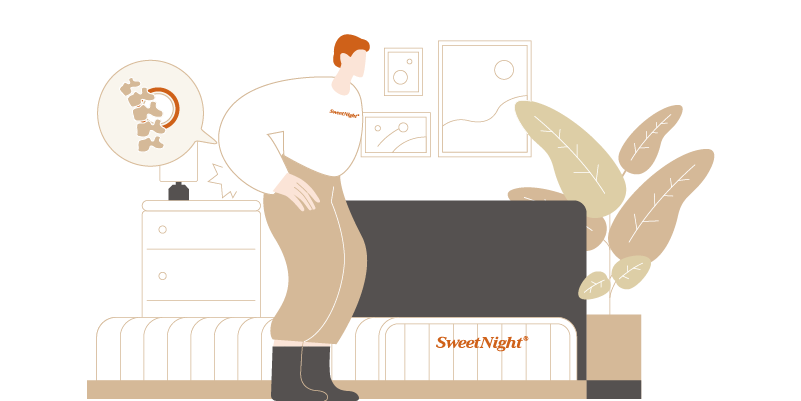Learning Center
How to Decompress the Spine While Sleeping?
Lower back pain has always been one of the most talked about topics for everyday sleepers. Improper posture when sitting and standing creates tension and long-term pain issues. As more and more people start to pay attention to the need to maintain a healthy spine, learning to decompress the spine while sleeping becomes an important practice. This article was written with the goal to show you how.

CONTENTS
- What causes spinal compression?
- How sleep affects your spine?
- The best solutions for decompressing the spine while sleeping
- How to get up with spine pain?
What causes spinal compression?

The most common factors affecting spinal discomfort would be fatigue, muscle strain, and illness. Fatigue and muscle strain can be relieved with rest and a warm bath. However, if the pain is severe and worsens over time, it may be due to musculoskeletal disorders, spinal injuries, or nerve problems.
Lower back pain is a common issue that many people face. It can be caused by a variety of factors, most commonly related to the bones, muscles, and spine. Some of the most common causes include osteoarthritis and degenerative changes in the discs and vertebrae. Another potential cause is spinal joint disease, which can cause damage to the joints between the vertebrae.
Back and lumbar pain can have various causes, and identifying the underlying issue is crucial for effective treatment. Including spinal deformities, infectious diseases affecting the spinal bones (such as osteomyelitis or tuberculosis), and even seemingly insignificant spinal injuries, such as falling from a height or landing on your back, can result in fractures and severe pain.
How sleep affects your spine?
Our body enters a state of relaxation and repair when we sleep. This is the perfect time for our spine to decompress and rejuvenate. However, the position in which we sleep can significantly impact this process. Sleeping on your stomach, for example, can put additional pressure on your spine and neck, leading to further compression.
It’s not just about the position in which we sleep. The quality of our mattress and pillow also plays a vital role in spinal health during sleep. A mattress that is too soft or too firm can cause spinal discomfort during sleep, while a pillow that is too high or too low can also strain your neck or cause a stiff neck.
How to get rid of these whole bunch of problems and get a restful night’s sleep? By the way, making sure our spine decompresses and wake up refreshed.
The best solutions for decompressing the spine while sleeping
CHOOSE THE RIGHT MATTRESS
Getting a restful and rejuvenated sleep is crucial for maintaining a healthy body and mind. Choosing the right mattress is one of the key ways to achieve this. Not only should you consider your sleeping environment and preferred sleeping position, but you should also take your body weight into account since different mattresses are designed to support different body shapes and needs.
A mattress's build can potentially how comfortable and supportive it is. With various components integrated into a mattress such as springs, memory foam, latex, and plant fibers(like coconut), the ratio of these components can have an impact on how well the mattress works. All these materials affect the overall mattress's thickness and can also affect the final firmness.
The most common thickness available on the market ranges from 6 inches to 14 inches, For people with a lighter body you need a mattress around 10-12 inches since it provides an ideal comfort layer thickness. Heavier individuals will require a mattress greater than 12 inches because there needs to be more sinking range and usually has more support material to resist the user's weight. It's crucial to note that if the sleeper is overweight, it can still cause back pain and spinal misalignment.
When it comes to mattress firmness, there are a variety of options to choose from. For individuals who prefer a more cushioned sleeping surface, softer and more flexible mattresses are better suited, whilst firmer mattresses offer greater support for those who want a more rigid sleeping surface. But in the final analysis, the sleeping experience is subjective. As a layman and an ordinary customer, we are not a pro in choosing mattress firmness and we don’t have so much knowledge backup to pick one mattress that can perfectly suit you. That can be solved, in an easy way - a flippable mattress that offers several firmness options. You don’t have to worry about which firmness fits you the best, and you can also turn it over or rotate it for different firmness levels in order to fit your needs.
SweetNight Prime Memory Foam Mattress comes with 4 firmness options in 1 mattress, which features a Contouring CurveTM design for your various requirements in different stages, such as injury, pregnancy, or any time you want to switch your sleeping preferences. A Prime Mattress provides balanced support and comfort that can relieve your pressure points and deliver proper spinal alignment, ensuring you can have a restful night's sleep.
USE THE RIGHT PILLOW
Just like the mattress, the pillow is a personal choice. For those suffering from asthma and allergies, it’s best to use non-natural pillows and mattresses to eliminate the risk of allergic reactions. It’s also important to choose a pillow neither too high nor too low, but rather creates a uniform position for the neck. There is no need to pay extra for those orthopedic pillows, a regular pillow works well already! By choosing the pillow that suits your personal taste and the material you prefer, with ideal size and height, maintaining your head, neck, and back in a proper line, you can still decompress your spine.
SLEEP ON YOUR SIDE OR BACK

Finding a perfect sleeping position can be a real challenge, the way that you sleep can affect your body in different ways. What kind of sleeping position can help you in decompressing your spine to some extent?
Sleeping on your back, also known as the supine position, can alleviate pain in a way. Lying on a bed with your knees bent can reduce low back pain. Additionally, sleeping on your back can also prevent acid reflux if you prop your head a little higher. However, it may increase the likelihood of snoring.
On the other hand, sleeping on your side is an excellent choice for spinal decompression because it can ease neck and spinal pain, which is an ideal sleeping position for pregnant women. In order to keep your spine properly aligned, a supportive mattress and a pillow can help you a lot. Regardless sleeping position you favor, it’s essential to prioritize comfort and support while sleeping.
Sleep on your stomach
If due to injury or other circumstances, you can only sleep on your stomach, there are available devices that can alleviate pain. You can place a body pillow, rolled-up towel, or small pillow under the groin and pelvic area. This is necessary to prevent the lumbar region from bending forward, straining muscles, and compressing the intervertebral discs. Using a waist belt or corset around the waist can be helpful, and if none is available, you can tightly tie a towel around your front before sleeping and knot it at the front. This will help keep your lower back in a fixed position and prevent it from tilting forward when you lie down.
How To Get Up With Spine Pain?
In addition to getting a good night's sleep, it is important to get out of bed in a way that does not exacerbate the pain. After waking up, it is necessary to stretch the muscles of the legs and arms by bending and straightening them several times while lying in bed. Then, slowly roll onto your stomach if you were sleeping on your back, lowering one leg and resting on the knee, gradually shifting the weight of your entire body onto your hands and supporting leg. Then, rise slowly without jerking, relying on both hands and legs, thus unloading the lumbar area. It is important to remember that sudden bends and twists can provoke back pain, so movements should be smooth and unhurried.
You can stand up by rolling onto your side and bending your knees parallel to each other, lifting your body with your hands while leaning on the edge of the bed, gradually lowering your legs off the bed. Keep your back straight when lifting. It is prohibited to get out of bed by lifting your back and bending your lower back, as this will lead to a sudden onset of pain.
Of course, for most patients, sleeping in the correct position alone will not eliminate the pain, so it is necessary to consult a doctor and receive treatment while ensuring proper rest and sleep.






